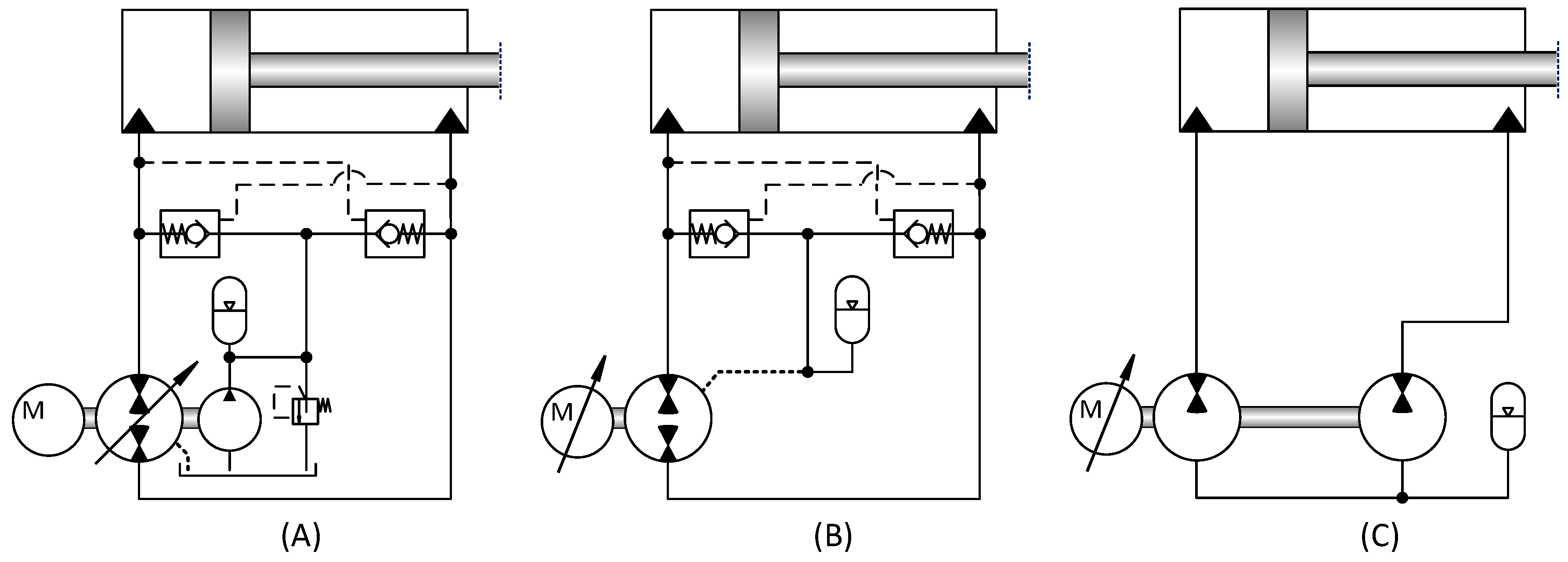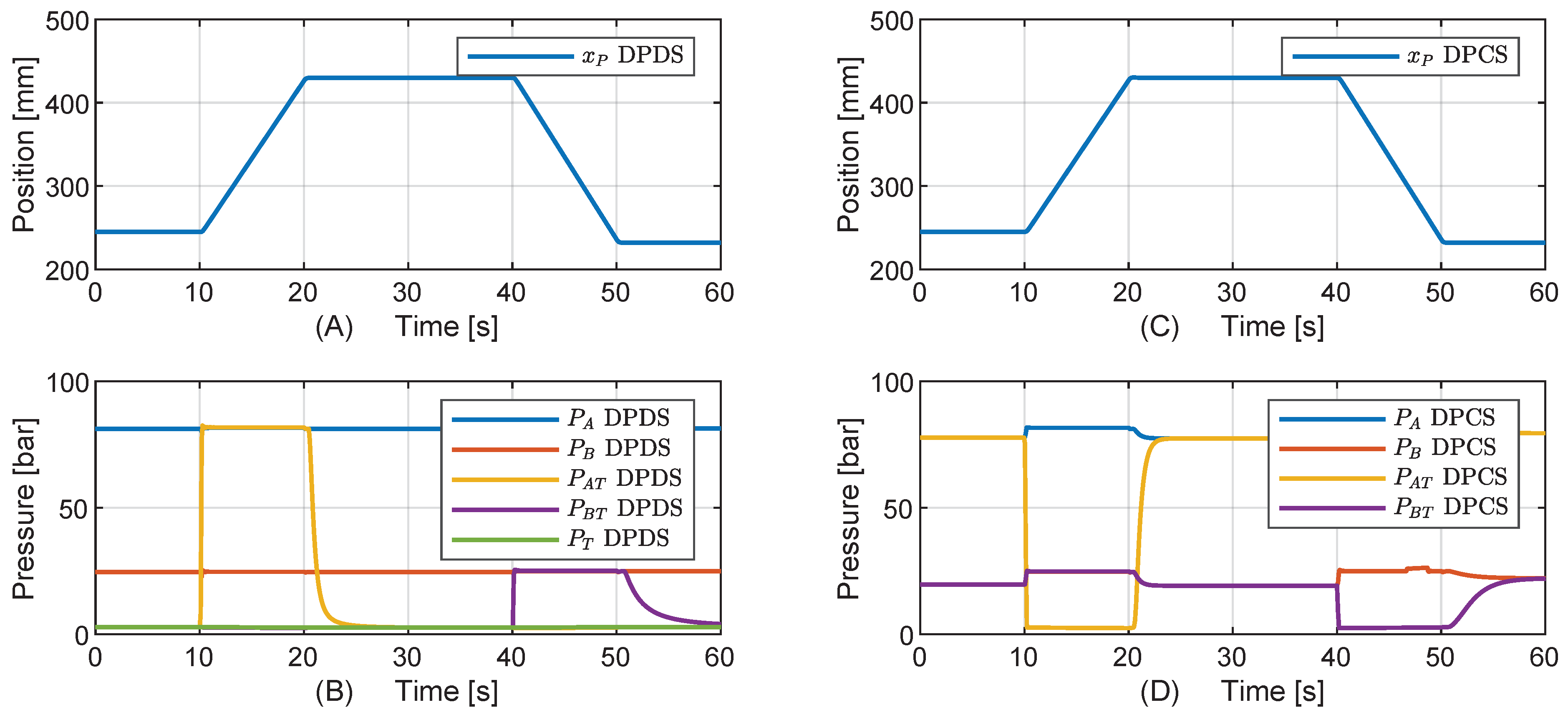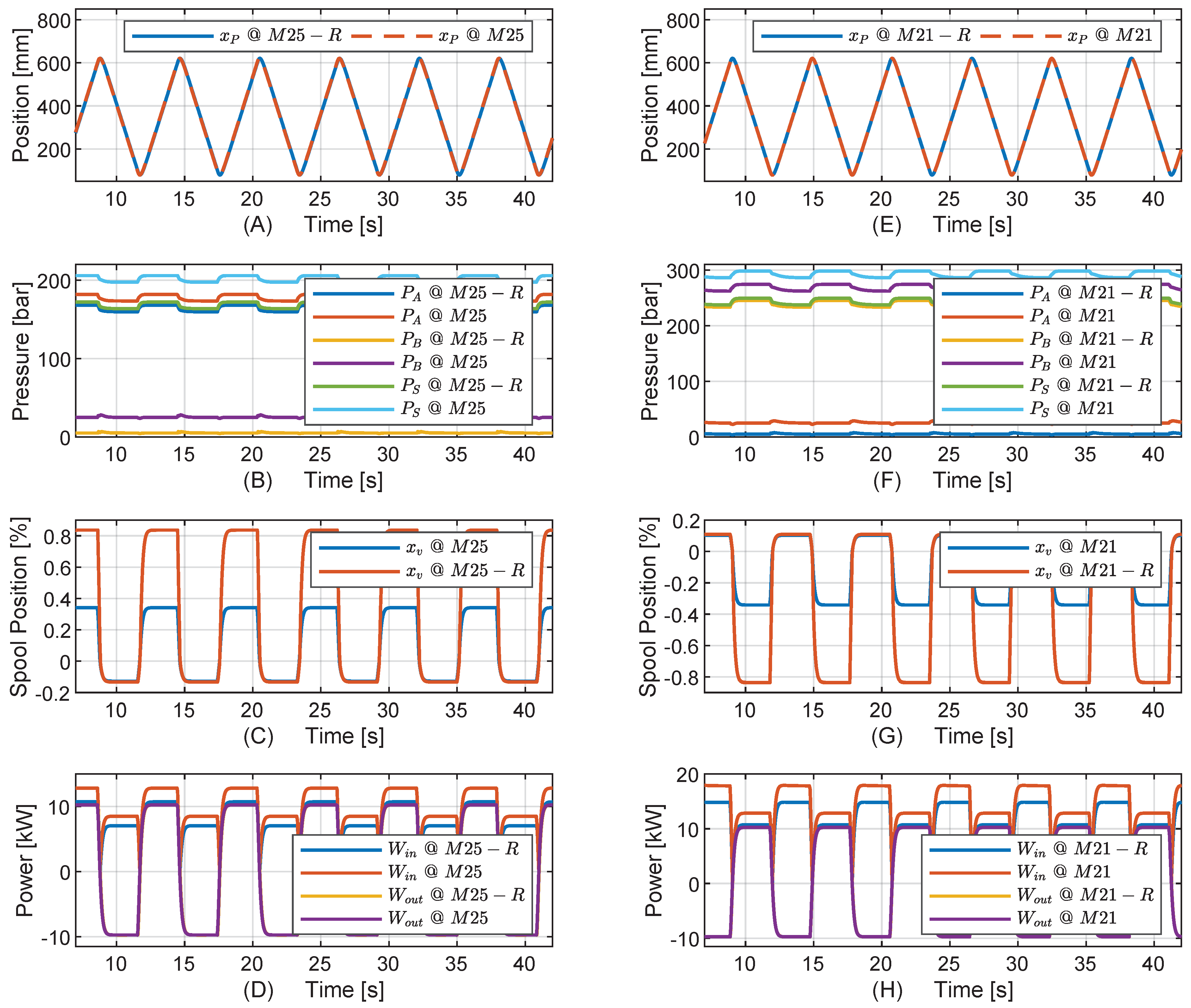A Class of Energy Efficient Self-Contained Electro-Hydraulic Drives with Self-Locking Capability
Abstract
:1. Introduction
1.1. Variable Displacement Approach
1.2. Variable Speed Approach with Single Fixed Displacement Pump
1.3. Variable Speed Approach with Two Fixed Displacement Pumps
1.4. An Industry Perspective
2. A Class of Drives with Self-Locking Capability
- Self-locking capability
- The drive concept is ideally self-locking, i.e., if the electric motor and the valves are not actuated, the cylinder piston is ideally locked. Hence, at stationary situations, the pump leakage balances the pressure difference across each pump, such that the common pump shaft is not loaded, and no energy consumption takes place. Hence, the self-locking feature allows to realize zero energy consumption when stationary (ideally). However, in the presence of even a small leakage the drive is not self-locking, but the leakage level may be significantly reduced compared to existing pump controlled drives as this is dictated by the valve and not the pump. In this case the drive may be referred to as a quasi self-locking drive.
- Separate forward & return flow paths
- This feature allows to control the pressure level of the cylinder, i.e., the lower chamber pressure. This in turn allows to control the cylinder drive stiffness, hence broadening the application range of the drive concept as discussed in the Introduction. On the other hand, this feature does not allow to regenerate energy when an external force is aiding the piston motion, and the power transferred by the load will be dissipated as heat in the drive. However, when the cylinder is supposed to carry out work, i.e., when the load is resistive, the power transmission can be rather efficient as the fluid is passed directly to the cylinder via the pump.
- Common return flow path
- The return flow passes a valve and is guided via a common path to the reservoir, allowing for cooling and filtration of the fluid. If realized properly, the fluid may be maintained in its design range regarding purity and temperature, hence viscosity, pivotal to the durability and reliability of the fluid itself, as well as the components. Note furthermore that the fluid may be circulated from the reservoir via a pump and valve through the filtering and cooling path, while maintaining the piston position and hydraulic output force constant.
Realizing a Class of Drive Architectures with Self-Locking Capability
3. Loss Analysis, Recovery Potential & Comparison with Conventional Valve Solutions
3.1. Loss Analysis of Drive Architectures without Energy Recovery Ability
3.2. Energy Recovery Potential
3.3. Comparison with Conventional Valve Solutions
3.4. Summary of Energy Analysis
4. Dynamic Modeling, Basic Controls & Performance
4.1. Application Subject for Study
4.2. Modeling
4.2.1. Hydraulic Model—DPCS/DPCS-R
4.2.2. Hydraulic Model—DPDS/DPDS-R
4.3. Basic Control Design
4.3.1. Model Simplification for Use in Control Design
4.3.2. Linear Model
4.3.3. Dynamic Analysis & Control Design
4.4. Drive Performance
4.4.1. Basic Properties
4.4.2. Motion Performance & Energy Efficiency
5. Industrial Feasibility Study
5.1. Application Range & Scalability
Reliability & Durability
5.2. Realization Cost
6. Conclusions
Author Contributions
Funding
Conflicts of Interest
Appendix A

| Verified Parameters from Test Bench | |||
| Parameter | Value | Unit | Description |
| [cm] | Piston side (A-side) area. | ||
| [cm] | Rod side (B-side) area. | ||
| 6480 | [Ns/m] | Viscous friction coefficient. | |
| [L/min/bar] | Leakage coefficient for pump A. | ||
| [L/min/bar] | Leakage coefficient for pump B. | ||
| [L/rev] | Theoretical displacement of pump A. | ||
| [L/rev] | Theoretical displacement of pump B. | ||
| [Nm] | Coulomb friction coefficient of pump A. | ||
| [Nm s/rad] | Viscous friction coefficient of pump A. | ||
| [Nm/bar] | Directional dependent load torque coefficient of pump A. | ||
| [Nm/bar] | Load torque coefficient of pump A. | ||
| [Nm] | Coulomb friction coefficient of pump A. | ||
| [Nm s/rad] | Viscous friction coefficient of pump A. | ||
| [Nm/bar] | Directional dependent load torque coefficient of pump A. | ||
| [Nm/bar] | Load torque coefficient of pump A. | ||
| 700 | [mm] | Piston stroke. | |
| M | 658 | [Ns/m] | Mass of piston and load. |
| [bar] | Athmospheric pressure. | ||
| [L] | Volume of A-side chamber with fully retracted piston. | ||
| [L] | Volume of B-side chamber with fully retracted piston. | ||
| 0.69 | [-] | Cylinder Area Ratio. | |
| 7500 | [bar] | Maximum effective bulk modulus. | |
| Percentage air in the fluid. | |||
| Adiabatic constant. | |||
| [rad/s] | Small signal bandwidth of electroc motor + drive. | ||
| [rad/s] | Small signal bandwidth of 2/2 valves. | ||
| Damping ratio of electroc motor + drive. | |||
| 0.69 | [-] | Valve flow gain ratio. | |
| 1 | Damping ratio of 2/2 valves. | ||
| Additional Parameters Used in Simulation Study | |||
| Parameter | Value | Unit | Description |
| [L/min/] | Static valve flow gain. | ||
| [L/min/] | Static valve flow gain. | ||
| [L/min/] | Static check valve flow gain. | ||
| [L/min/] | Static check valve flow gain. | ||
| [L] | Accumulator volume. | ||
| [L] | Volume between pump A and related check valves. | ||
| 1 | [L] | Return line volume. | |
| [L] | Dead volume of accumulator and related connections. | ||
References
- Ketelsen, S.; Padovani, D.; Andersen, T.; Ebbesen, M.; Schmidt, L. Classification and Review of Pump-Controlled Differential Cylinder Drives. Energies 2019, 12, 1293. [Google Scholar] [CrossRef]
- Berbuer, J. Neuartige Servoantriebe mit Primärer Verdrängersteuerung. Ph.D. Thesis, RWTH Aachen, Aachen, Germany, 1988. (In German). [Google Scholar]
- Rahmfeld, R.; Ivantysynova, M. Energy Saving hydraulic actuators for mobile machines. In Proceedings of the Bratislavian Fluid Power Conference, Častá-Píla, Slovakia, 2–3 June 1998. [Google Scholar]
- Rahmfeld, R.; Ivantysynova, M. Displacement controlled linear actuator with differential cylinder—A way to save primary energy in mobile machines. In Proceedings of the Fifth International Conference on Fluid Power Transmission and Control, Hangzhou, China, 4–5 April 2001. [Google Scholar]
- Rahmfeld, R.; Ivantysynova, M.; Weber, J. Displacement Controlled Wheel Loader- a simple and clever Solution. In Proceedings of the 4th International Fluid Power Conference, Dresden, Germany, 23–24 March 2004; pp. 183–196. [Google Scholar]
- Schneider, M.; Koch, O.; Weber, J. Green Wheel Loader—Improving fuel economy through energy efficient drive and control concepts. In Proceedings of the 10th International Fluid Power Conference, Dresden, Germany, 8–10 March 2016. [Google Scholar]
- Williamson, C.; Zimmerman, J.; Ivantysynova, M. Efficiency study of an excavator hydraulic system based on displacement-controlled actuators. In Proceedings of the 21st Fluid Power and Motion Control Symposium, Bath, UK, 10–12 September 2008; pp. 291–307. [Google Scholar]
- Zimmerman, J.D.; Ivantysynova, M. Reduction of Engine and Cooling Power by Displacement Control. In Proceedings of the 6th FPNI PhD symposium, West Lafayette, IN, USA, 15–19 June 2010; pp. 339–352. [Google Scholar]
- Zimmerman, J.; Busquets, E.; Ivantysynova, M. 40% fuel savings by displacement control leads to lower working temperatures—A simulation study and measurements. In Proceedings of the 52nd National Conference on Fluid Power, Las Vegas, NV, USA, 23–25 March 2011; pp. 693–702. [Google Scholar]
- Busquets, E.; Ivantysynova, M. The World’s First Displacement-Controlled Excavator Prototype With Pump Switching—A Study of the Architecture and Control. In Proceedings of the 9th JFPS International Symposium on Fluid Power, Matsue, Japan, 28–31 October 2014. [Google Scholar]
- Busquets, E.; Ivantysynova, M. A Multi-Actuator Displacement-Controlled System with Pump Switching—A Study of the Architecture and Actuator-Level Control. JFPS Int. J. Fluid Power Syst. 2015, 8, 66–75. [Google Scholar] [CrossRef]
- Bosch Rexroth AG. SHA Servo-Hydraulic Actuator. 2017. Available online: https://dc-corp.resource.bosch.com/media/general_use/products/industrial_hydraulics_1/systems_1/20170915_Kundeninformation_SHA_EN.pdf (accessed on 3 April 2019).
- Bosch Rexroth AG. Advantages of Electrification and Digitalization Technology For Hydraulics. 2018. Available online: https://www.boschrexroth.com/en/xc/products/product-groups/industrial-hydraulics/the-fitness-program-for-hydraulics (accessed on 3 April 2019).
- Padovani, D.; Ketelsen, S.; Hagen, D.; Schmidt, L. A Self-Contained Electro-Hydraulic Cylinder with Passive Load-Holding Capability. Energies 2019, 12, 292. [Google Scholar] [CrossRef]
- Imam, A.; Rafiq, M.; Jalayeri, E.; Sepehri, N. Design, Implementation and Evaluation of a Pump-Controlled Circuit for Single Rod Actuators. Actuators 2017, 6, 10. [Google Scholar] [CrossRef]
- Michel, S.; Weber, J. Electrohydraulic Compact-drives for Low Power Applications considering Energy-efficiency and High Inertial Loads. In Proceedings of the 7th FPNI PhD Symposium on Fluid Power, Reggio Emilia, Italy, 27–30 June 2012; pp. 1–18. [Google Scholar]
- Michel, S.; Weber, J. Energy-efficient electrohydraulic compact drives for low power applications. In Proceedings of the ASME/BATH 2012 Fluid Power andMotion Control, Bath, UK, 12–14 September 2012; pp. 93–107. [Google Scholar]
- Çalışkan, H.; Balkan, T.; Platin, B.E. A Complete Analysis for Pump Controlled Single Rod Actuators. In Proceedings of the 10th International Fluid Power Conference, Dresden, Germany, 8–10 March 2016; pp. 119–132. [Google Scholar] [CrossRef]
- Çalışkan, H.; Balkan, T.; Platin, B.E. A Complete Analysis and a Novel Solution for Instability in Pump Controlled Asymmetric Actuators. J. Dyn. Syst. Meas. Control 2015, 137, 091008. [Google Scholar] [CrossRef]
- Brahmer, B. CLDP—Hybrid Drive using Servo Pump in Closed Loop. In Proceedings of the 8th International Fluid Power Conference, Dresden, Germany, 26–28 March 2012; pp. 93–102. [Google Scholar]
- Minav, T.; Panu, S.; Matti, P. Direct-Driven Hydraulic Drive Without Conventional Oil Tank. In Proceedings of the ASME/BATH Symposium on Fluid Power & Motion Control, FPMC2014, Bath, UK, 10–12 September 2014; pp. 1–6. [Google Scholar] [CrossRef]
- Filatov, D.; Minav, T.; Heikkinen, J.E. Adaptive Control for Direct-Driven Hydraulic Drive. In Proceedings of the 11th International Fluid Konference, Aachen, Germany, 19–21 March 2018. [Google Scholar]
- Minav, T.; Bonato, C.; Sainio, P.; Pietola, M. Direct Driven Hydraulic Drive. In Proceedings of the 9th International Fluid Power Conference (IFK), Aachen, Germany, 24–26 March 2014; pp. 7–11. [Google Scholar] [CrossRef]
- Järf, A.; Minav, T.; Pietola, M. Nonsymmetrical Flow Compensation Using Hydraulic Accumulator. In Proceedings of the 9th FPNI Ph.D. Symposium on Fluid Power FPNI2016, Florianópolis, SC, Brazil, 26–28 October 2016; pp. 1–6. [Google Scholar] [CrossRef]
- Pedersen, H.C.; Schmidt, L.; Andersen, T.O.; Brask, M.H. Investigation of New Servo Drive Concept Utilizing Two Fixed Displacement Units. JFPS Int. J. Fluid Power Syst. 2014, 8, 1–9. [Google Scholar] [CrossRef] [Green Version]
- Schmidt, L.; Roemer, D.B.; Pedersen, H.C.; Andersen, T.O. Speed-Variable Switched Differential Pump System for Direct Operation of Hydraulic Cylinders. In Proceedings of the ASME/BATH 2015 Symposium on Fluid Power and Motion Control, Chicago, IL, USA, 14–16 October 2015. [Google Scholar]
- Schmidt, L.; Groenkjaer, M.; Pedersen, H.C.; Andersen, T.O. Position Control of an Over-Actuated Direct Hydraulic Cylinder Drive. Control Eng. Pract. 2017, 64, 1–14. [Google Scholar] [CrossRef]
- Ketelsen, S.; Schmidt, L.; Donkov, V.H.; Andersen, T.O. Energy Saving Potential in Knuckle Boom Cranes using a Novel Pump Controlled Cylinder Drive. Modeling Identif. Control 2018, 39, 73–89. [Google Scholar] [CrossRef]
- Servi Group. Servi Hybrid Drive. Linear Actuator. 2017. Available online: https://www.servi.no/media/documents/Hybrid_Cylinder_1705-1_NO.pdf (accessed on 3 April 2019).
- Michel, S.; Schulze, T.; Weber, J. Energy-efficiency and thermo energetic behaviour of electrohydraulic compact drives. In Proceedings of the 9th International Fluid Power Conference (IFK), Aachen, Germany, 24–26 March 2014. [Google Scholar]
- Michel, S.; Weber, J. Prediction of the thermo-energetic behaviour of an electrohydraulic compact drive. In Proceedings of the 10th International Fluid Power Conference (IFK), Dresden, Germany, 8–10 March 2016; pp. 219–234. [Google Scholar]
- Michel, S.; Weber, J. Investigation of Self-Contamination of Electrohydraulic Compact Drives. In Proceedings of the 10th JFPS International Symposium on Fluid Power, Fukuoka, Japan, 24–27 October 2017. [Google Scholar]
- Costa, G.K.; Sepehri, N. Hydrostatic Transmissions and Actuators: Operation, Modelling and Applications; Wiley: Hoboken, NJ, USA, 2015. [Google Scholar]
- Andersen, T.O.; Hansen, M.R. Fluid Power Systems—Modelling and Analysis, 2nd ed.; Aalborg University: Aalborg, Denmark, 2003. [Google Scholar]














| Quadrant | DPCS/DPDS | DPCS-R/DPDS-R @ , aux. Valves Only | Conventional Valve Solution |
|---|---|---|---|
| Power Losses | |||
| Q1: | |||
| Q1-2: | |||
| Q2: | |||
| Q4: | |||
| Q3-4: | |||
| Q3: | |||
| DPCS/DPDS/VCD | |||||
| / | [kN] | [kN] | [kN] | [kN] | [kN] |
| [m/s] | M11 | M12 | M13 | M14 | M15 |
| [m/s] | M21 | M22 | M23 | M24 | M25 |
| DPCS-R/DPDS-R/VCD-R | |||||
| / | [kN] | [kN] | [kN] | [kN] | [kN] |
| [m/s] | M11-R | M12-R | M13-R | M14-R | M15-R |
| [m/s] | M21-R | M22-R | M23-R | M24-R | M25-R |
| —DPCS/DPDS/VCD | |||||
| / | [kN] | [kN] | [kN] | [kN] | [kN] |
| [m/s] | 71/71/32 | 57/57/27 | 7/7/4 | 65/65/40 | 76/76/48 |
| [m/s] | 71/71/33 | 58/58/28 | 13/13/8 | 65/65/40 | 77/76/48 |
| —DPCS-R/ DPDS-R/VCD-R | |||||
| / | [kN] | [kN] | [kN] | [kN] | [kN] |
| [m/s] | 89/89/38 | 85/86/37 | 20/21/21 | 90/90/56 | 91/91/58 |
| [m/s] | 84/84/40 | 76/76/39 | 18/18/34 | 86/86/56 | 90/90/57 |
| Self-Contained Drives | 10 [kW] Version | 45 [kW] Version | ||
| Pump A: | 1 pcs. | AZPF 8 ccm/rev | 1 pcs. | AZPG 45 ccm/rev |
| Pump B: | 1 pcs. | AZPF 5.5 ccm/rev | 1 pcs. | AZPG 32 ccm/rev |
| Check valves: | 5 pcs. | M-SR 8 | 5 pcs. | M-SR 20 |
| Prop. valves: | 4 pcs. | KKDSR1 | 8 pcs. | KKDSR2 |
| Valve amplifiers: | 4 pcs. | VT-SSPA-1 | 8 pcs. | VT-SSPA-1 |
| Electric motor: | 1 pcs. | MOT-FC 160M/11kW | 1 pcs. | MOT-FC 225M/45kW |
| Frequency drive: | 1 pcs. | EFC5610 11kW | 1 pcs. | EFC5610 45kW |
| Accumulator: | 1 pcs. | HAB 10 | 1 pcs. | HAB 10 |
| Conventional valve drives | 10 [kW] Version | 45 [kW] Version | ||
| Control valve: | 1 pcs. | 4WRSEH 6 | 1 pcs. | 4WRSEH 10 |
| Electric motor: | 1 pcs. | MOT-FC 160M/11kW | 1 pcs. | MOT-FC 225M/45kW |
| Power electronics: | 1 pcs. | 10 kW rating | 1 pcs. | 45 kW rating |
| Variable displacement pump: | 1 pcs. | A10VSO 18 DR | 1 pcs. | A10VSO 100 DR |
| Reservoir: | 1 pcs. | 120 L type | 1 pcs. | 585 L type |
© 2019 by the authors. Licensee MDPI, Basel, Switzerland. This article is an open access article distributed under the terms and conditions of the Creative Commons Attribution (CC BY) license (http://creativecommons.org/licenses/by/4.0/).
Share and Cite
Schmidt, L.; Ketelsen, S.; Brask, M.H.; Mortensen, K.A. A Class of Energy Efficient Self-Contained Electro-Hydraulic Drives with Self-Locking Capability. Energies 2019, 12, 1866. https://doi.org/10.3390/en12101866
Schmidt L, Ketelsen S, Brask MH, Mortensen KA. A Class of Energy Efficient Self-Contained Electro-Hydraulic Drives with Self-Locking Capability. Energies. 2019; 12(10):1866. https://doi.org/10.3390/en12101866
Chicago/Turabian StyleSchmidt, Lasse, Søren Ketelsen, Morten Helms Brask, and Kasper Aastrup Mortensen. 2019. "A Class of Energy Efficient Self-Contained Electro-Hydraulic Drives with Self-Locking Capability" Energies 12, no. 10: 1866. https://doi.org/10.3390/en12101866





